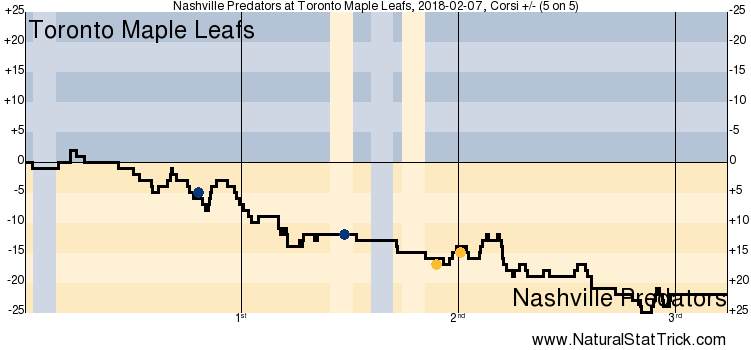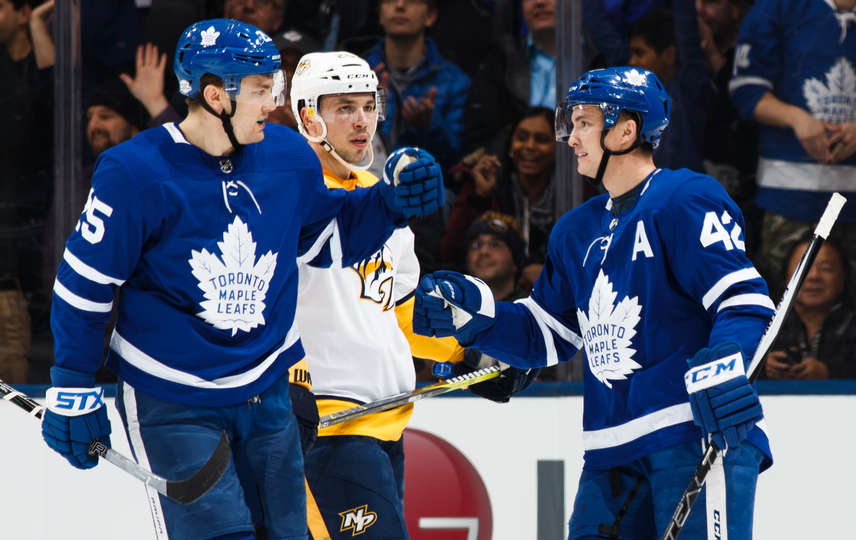On the back of a first-star performance from Frederik Andersen, the Toronto Maple Leafs picked up their sixth win in their last seven games over the Central Division-leading Nashville Predators on Wednesday night.
Let’s mix up the format for this review and highlight five key takeaways from the game.
The Freddy Andersen Show
Take a bow, Frederik Andersen, for a first, second and third star performance. A lot of attention went to the groin-stretching game saving-save on Ryan Johansen’s wrap-around in the final minute followed by the shootout stops, but Andersen pulled off two point-blank saves at critical junctures in the first and second periods, too, to pave the way for the Leafs to take the lead and hold onto it as long as they did. He also just faced a tonne of rubber in general (46 shots against). Andersen now leads the NHL in 40+ save wins with five – if this isn’t catching the attention of Vezina voters…
Andersen has been better across the board in all the major statistical categories, but the significant points swing thanks to his performance in the shootout is worth highlighting – last season, he went 1-7 while stopping just 12 of 23 (.522 sv%); so far this season, he is 5-1 after stopping 21 of 27 (.778 sv%). Among goalies that have faced 15 or more shots in the shootout, Andersen is third of 15 in save percentage. Last year, he was 31 of 33 in that statistic.
While the Leafs are in a strange (but mostly positive) position where they’re a lock for a divisional playoff spot but could be walking into a buzzsaw in round 1 against one of Boston or Tampa Bay, Andersen proving he can steal games as often as he has this year is a wildcard entering any playoff series. Andrei Vasilevsky and Tuukka Rask are crushing it, too, in Tampa and Boston, respectively, but Andersen looks like he could go toe-to-toe with either of those guys and could end up outplaying them over the course of a series.
Kasperi Kapanen grabbing his opportunity with both hands
In addition to his incredible individual effort for his 2-0 shorthanded goal, it’s a real testament to Kasperi Kapanen’s development that he showed as one of the Leafs’ more competitive players against an experienced, heavy team like Nashville. That fourth-line duo, with Leo Komarov opposite Kapanen, looked good again in this game, finishing top of the team in possession (58%) as the only three Leaf forwards to break even alongside Dominic Moore. Komarov and Kapanen should provide two-thirds of a balanced L4 that will help tilt the ice and capture momentum for the rest of the lineup in down-the-stretch, playoff-style hockey.
Mike Babcock’s answer about Kapanen sticking after the game pretty much confirmed it: Kapanen has kicked down the door on an NHL job and hasn’t left it even a crack open for the Leivos and Martins of the world looking to get back into the lineup.
It seems clear Babcock is looking for the final puzzle piece at center ice to turn the Leafs into a real four-line hockey club capable of competing over a long series against Boston or Tampa Bay in round 1. Dominic Moore sat on the bench a lot after his late second-period penalty – an undisciplined cross-check in the o-zone – and finished at 9:21 TOI while winning just 21% of his faceoffs. Auston Matthews took his spot in the fourth-line rotation in the third period, which is something we’ve seen in the later stages of recent games. It’s pretty obvious what Babcock has written down at the top of his trade deadline wishlist.
Out-Possessed Again by a Heavy Team
In the last two games vs. the Ducks and Predators, the Leafs have been out-possessed 60-40 in each of the first, second and third periods. Score effects factor in, but the Predators controlled 72% of the shots on goal in the third period after tying the game up early in the final frame.

The Leafs aren’t incapable of tilting the ice in their favour and taking over games, but it’s usually achieved by hurrying the opposition into mistakes and forcing them into uncomfortable spots defensively through closing quickly all over the ice, and then coming at teams in waves. They tend to chase the puck a lot against teams like the Predators, Blues and Bruins, who have a lot of experience in how to be/play heavy; they’ll hit you off the puck and are aggressive activating their D into the forecheck/jamming the walls.
The Leafs are out-possessed in a lot of the games against these kinds of teams, but to their credit, through their speed, scoring depth and opportunistic offense — and some sublime goaltending from Andersen — they have gotten quite a few points and wins against the run of play.
The fact of the matter is that, while Toronto hung in admirably in every single game of the quarterfinal series, Washington edged out the Leafs in the playoffs last Spring for a lot of the same reasons. Looking at games like this one, it’s hard to dispel the notion that the Leafs don’t appear to be quite “there” yet 10 months later. That doesn’t mean they don’t have the speed, skill, depth and goaltending to make things very interesting, though.
Faceoff Struggles
The Leafs lost a ton of puck battles to the Predators throughout the night, beginning in the faceoff circle, where they went 40%. It’s not been an issue for the Leafs in the big picture this season, as they’ve improved to ninth in the NHL with a 51.4% success rate on the dot a year after finishing 15th at 49.9%. But there were two examples back-to-back in the final minute of the game that easily could have lost the Leafs the game, and it was the product of as many as three or four Leafs not digging in and getting outcompeted off the draw at a critical juncture.
That stuff will drive Babcock bananas.
Auston Matthews vs. Top Competition
After a 14% CF night head to head against Ryan Johansen, here are Auston Matthews’ possession splits against some of the top centers he’s lined up against as his primary matchup in recent games (he faced Barzal and Tavares a similar amount vs. NYI, so I included both):
| Matchup | Matthews h2h CF% |
|---|---|
| vs. Toews | 27% |
| vs. Couturier | 48% |
| vs. Bergeron | 18% |
| vs. Barzal | 45% |
| vs. Tavares | 32% |
| vs. Schenn | 41% |
| vs. Kesler | 56% |
| vs. Johansen | 14% |
You can nitpick here and there about score effects in some cases, the fact that he scored in some of these games and that’s more important, the fact that CF% isn’t everything, or that there are two linemates and a defence pair on the ice with him. Those would all be fair points to varying degrees. But he only broke even possession-wise against Ryan Kesler among that group of centers, and Kesler is playing through considerable pain and doesn’t look right out there.
Even based just on the eye test, it’s hard to argue Matthews has consistently looked like himself during this recent stretch since returning from injury, especially in those tough matchups against top centers on good teams.
It’s hard to say if an injury is factoring in here, or if it was the time on the shelf that’s had him playing catch-up a little bit, or if it’s just all part of gaining experience in the league for a 20-year-old player. But Matthews certainly has more to give in those situations going forward. The good news? It’s a pretty good bet that he will. He’s also on pace for 39 goals despite missing 10 games due to injury – there’s that, too.




































